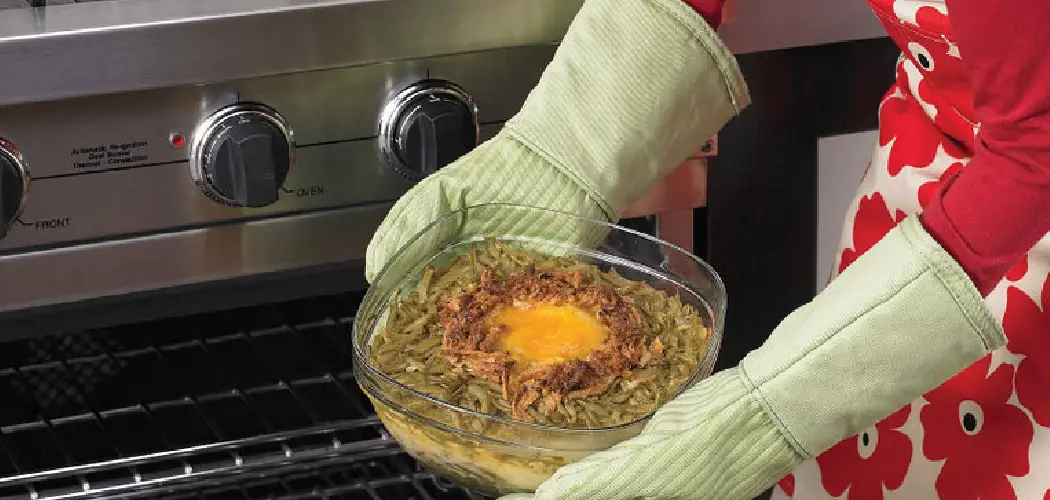Are you trying to figure out if your glass container is oven-safe? Oven-safe glassware can make all the difference when it comes to cooking. Whether you’re roasting a chicken or reheating leftovers, having oven-safe containers nearby makes life much simpler! However, not every type of glass can withstand high temperatures without cracking and breaking. That’s why figuring out how to tell whether a piece of glass is suitable for use in the oven is so important.
In this blog post on how to tell if glass is oven safe, we’ll explain how to assess which types of kitchenware are best suited for use in the heat – from specific brand recommendations to safety trends and tips. Read on for more information about how to determine if your chosen vessel can handle those intense temperatures!
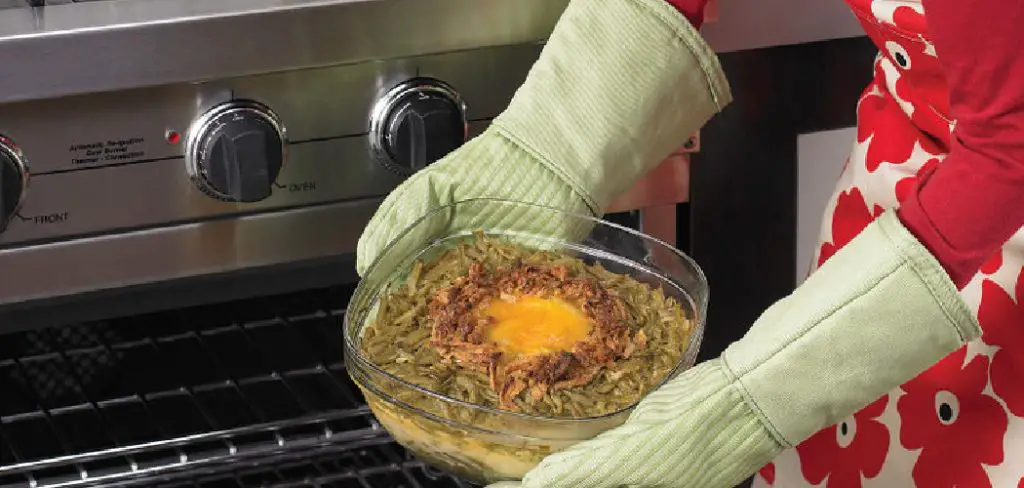
Understanding Glass Types for Oven Use
Tempered Glass
Tempered glass is a type of safety glass that has been heat-treated to increase its strength, making it more resistant to breakage. This process also improves its thermal shock resistance, meaning it can withstand sudden changes in temperature without cracking or shattering. This makes it an ideal choice for bakeware and casserole dishes where dramatic shifts in temperature are common.
Borosilicate Glass
Borosilicate glass is renowned for its exceptional heat tolerance and chemical stability. The high heat tolerance allows it to withstand intense oven temperatures, making it a popular choice for cooking and baking. Known brands that make borosilicate glass products include Pyrex and Duran.
Soda-Lime Glass
In contrast, soda-lime glass has lower heat resistance and is more susceptible to thermal shock. This makes it less suitable for oven use but still popular in non-oven applications, such as drinkware and decorative items.
Crystal Glass
Crystal glass, known for its high lead content, can pose potential hazards when heated. The lead can leach into food or drink, posing a health risk. Therefore, crystal glassware is generally recommended for non-oven use, such as serving drinks or displaying decorative items.
Safety Precautions
When it comes to knowing which glassware is suitable for oven use, safety should always be your number one priority. To make sure that your food and the equipment you’re using are safe, here are some key points to consider:
- Avoid Using Vintage or Antique Glassware in an Oven – Even if You Know the Manufacturer of the Glass, It May Not Be Designed to Handle the High Temperatures of an Oven.
- Always Check for Oven-Safe Symbols or Labels When Choosing Glassware, as They Will Indicate Which Products Are Approved for Use in the Heat. If You Can’t Find Any Indication That a Piece of Glass is Oven-Safe, It’s Best to Choose Another Option!
- If You’re Purchasing Glassware From a Store or Online, Make Sure That It is Labeled as Oven-safe. Many Companies Will Explicitly Indicate This in Their Product Descriptions and on the Packaging.
10 Step-by-step Guides on How to Tell if Glass is Oven Safe
Step 1: Check the Packaging or Instructions
Most glassware products will indicate on their packaging whether they are oven-safe or not. If you can’t find this information on the label, check the manufacturer’s website for more details about each product before using it in an oven. It’s always best to double-check! But if you can’t find any indication that the glass is oven-safe, then it’s probably not a good candidate for use in the heat.
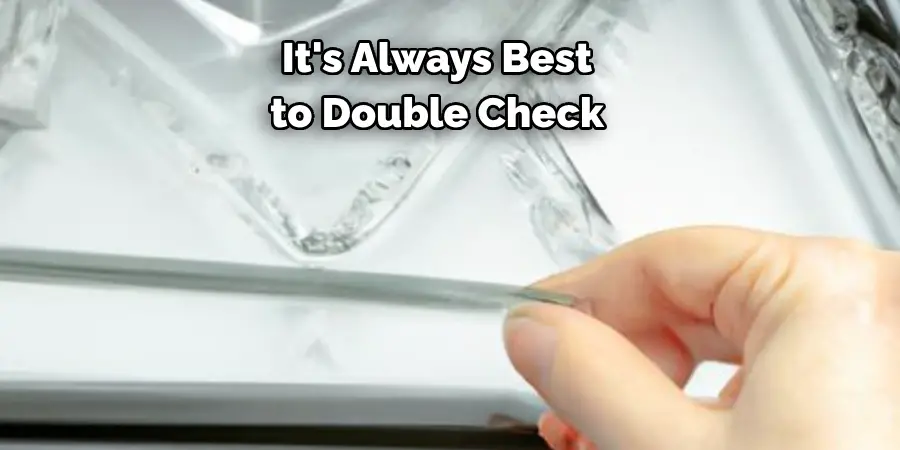
Step 2: Consider the Material
Not all types of glass are suitable for use in an oven. For example, some types of tempered glass (like Pyrex and Anchor Hocking) are designed to withstand high temperatures, while other types (like plate glass or window glass) are not. If you’re unsure what type of material your glassware is made from, it’s best to err on the side of caution and avoid using it in an oven.
Step 3: Look for Oven-Safe Symbols
Many manufacturers will include symbols or labels on their packaging that indicate whether the product is oven-safe. These symbols may vary from brand to brand, so it’s important to familiarize yourself with them before purchasing anything for use in the oven. Knowing what to look for ahead of time can help you quickly determine if a particular piece of glassware is suitable for oven use.
Step 4: Check the Manufacturer’s Website
If you can’t find any indication on the product packaging of whether a piece of glassware is oven-safe, check the manufacturer’s website for more information. Many companies will have detailed safety instructions and guidelines available online that will let you know which products are suitable for use in the oven.
Step 5: Look for Heat-Resistant Labels
Some manufacturers will indicate on their packaging that their products are heat-resistant or oven-safe. These labels can be helpful in quickly determining whether a piece of glassware is suitable for use in the heat. However, it’s important to make sure that you understand what the label is actually indicating – for example, a heat-resistant label does not necessarily mean that the item is oven-safe.
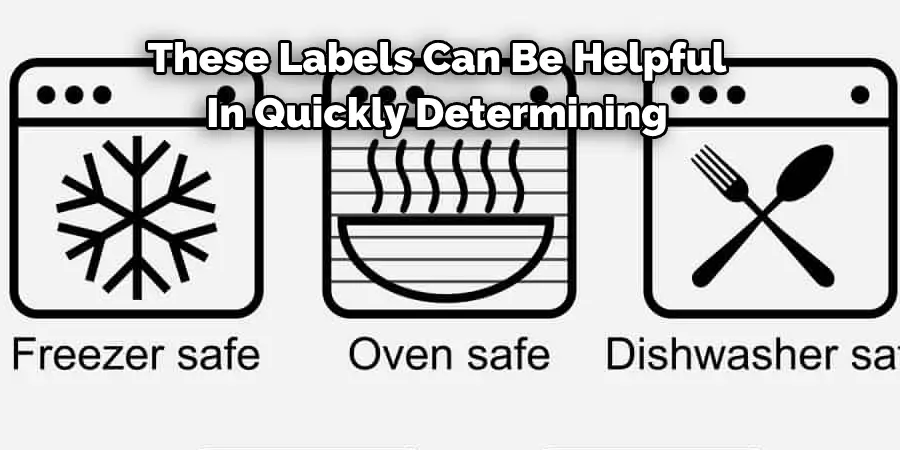
Step 6: Read the Care Instructions
If you’re not sure whether a piece of glassware can be used in an oven, it’s always best to read through the care instructions that came with the product. In many cases, these instructions will provide helpful information about which products are safe to use in the heat and which should be avoided. If you can’t find any care instructions for a particular item, it’s best to err on the side of caution and avoid using it in an oven.
Step 7: Ask an Expert
If you’re still unsure whether a piece of glassware is suitable for use in an oven, it’s always best to seek advice from a qualified expert. You can contact the manufacturer directly or speak to a kitchen specialist at your local store for more detailed information about which products are safe to use in the heat. It’s always better to make sure that you know what you’re doing before using any type of kitchenware in an oven.
Step 8: Consider the Temperature
Even if a piece of glassware is labeled as oven-safe, it may not be suitable for use in extremely high temperatures. It’s important to consider the type of food that you’re cooking, as well as the temperature and time settings for your oven. If you’re planning on using an item at very high temperatures (over 500°F), it’s best to double-check that it is suitable for use in the heat before proceeding.
Step 9: Use Caution
If you’re using glassware in an oven, always be sure to handle it with care. Make sure that you place the glassware on a flat surface and avoid any sudden temperature changes or violent movements that could cause it to break. It’s also important to avoid preheating the oven with the glassware inside, as this could lead to cracking or shattering.
Step 10: Clean Up With Caution
Glassware can become extremely hot when used in the oven, so it’s important to be careful when handling it after use. Let the glass cool down completely before attempting to clean or move it, and always use oven mitts or thick cloths when handling hot items.
By following these steps on how to tell if glass is oven-safe, you can ensure that your glassware is safe to use in an oven and help keep yourself and your kitchen equipment out of harm’s way!
Common Oven-Safe Glassware Brands
1. Pyrex
Pyrex is one of the most well-known brands when it comes to oven-safe glassware. The company’s products are made from borosilicate glass, which is highly resistant to thermal shock, making it ideal for oven use. Pyrex glassware is also known for its durability and long-lasting nature.
2. Anchor Hocking
Anchor Hocking is another popular brand that produces oven-safe glassware. Their products are made from tempered soda-lime-silicate glass, which can withstand high temperatures. Anchor Hocking’s glassware is often praised for its sturdiness and reliability.
3. CorningWare
CorningWare has been a trusted name in the kitchenware industry since the 1950s. Their glass-ceramic material (originally known as “Pyroceram”) was designed to resist thermal shock, making it perfect for oven use. CorningWare dishes are renowned for their versatility, able to go directly from the freezer to the oven without issue.
4. Arcuisine
Arcuisine’s oven-safe glassware, made in France, is known for its high resistance to thermal shock. Their products are made from borosilicate glass, ensuring safety and durability when used in the oven.
5. Duralex
Duralex is famous for its tempered glassware, which is oven-safe up to 300°C. Duralex products are highly resistant to thermal shock and also have a reputation for being incredibly durable and long-lasting.
By choosing products from these trusted and reliable brands, you can feel confident about using glassware in your oven safely and efficiently.
Types of Glass That Are Not Oven-Safe
Not all types of glass are suitable for oven use. Some, despite their seemingly robust nature, can shatter or crack under high temperatures, posing a serious safety risk. It’s essential to understand the different types of glassware that should not be used in the oven.
1. Regular Soda-Lime Glass
Regular soda-lime glass, commonly used to make items such as drinking glasses, jars, and vases, is not designed to withstand high temperatures. While it’s excellent for everyday use, it can shatter or crack if exposed to the heat of an oven.
2. Decorative Glassware
Decorative glass items, including those with painted designs or ornamental structures, are not suitable for oven use. The materials used in the decoration process can potentially melt or emit harmful fumes when exposed to high heat.
3. Crystal Glassware
While crystal glassware might exude elegance and durability, it’s not meant to be used in an oven. Crystal is sensitive to temperature changes and can easily crack or break when heated.
4. Cheap Glass Cookware
Not all glass cookware is oven-safe. Cheaper, less durable glassware can crack under the pressure of high heat. Avoid using any unbranded or suspiciously cheap glass cookware in the oven.
5. Glass with Metallic Edging
Glassware with metallic edging or details should not be used in the oven. The metal can heat up to dangerous levels, potentially causing the glass to crack and the metal to warp or melt.
By being aware of the types of glass that are not oven-safe, you can prevent accidents in the kitchen and ensure the longevity of your glassware. Always remember to check the manufacturer’s guidelines before using any glass item in an oven.
Safety Tips for Using Glass in the Oven
When using glassware in the oven, it’s crucial to follow safety precautions to ensure a smooth and secure cooking experience. Here are some additional tips:
1. Gradual Temperature Change
Avoid subjecting your glassware to sudden temperature changes, as this can cause thermal shock, leading to cracks or breakage. Instead, allow your glassware to adjust to temperature changes—for instance, gradually, don’t transfer a hot glass dish directly from the oven to a cold countertop.
2. Use Heat-Resistant Oven Mitts
Always use heat-resistant oven mitts to protect your hands from burns when handling hot glassware. Regular kitchen towels or cloths may not provide adequate protection from the extreme heat.
3. Do Not Add Liquid to a Hot Glass Dish
Never pour cold liquid into a hot glass dish. The sudden temperature change could cause the glass to fracture. Allow the dish to cool down before adding any liquid to it.
4. Do Not Use Damaged Glassware
Inspect your glassware regularly, and do not use it if you notice any chips, cracks, or damage. Even a small crack can expand when exposed to high temperatures, potentially causing the glass to shatter.
5. Avoid Overcrowding the Oven
Keep a safe distance between glassware items in the oven to allow heat to circulate evenly and to prevent the dishes from touching, which could lead to breakage.
6. Follow Manufacturer’s Guidelines
Different brands of glassware have additional resistance to heat. Always follow the manufacturer’s guidelines for using and maintaining the glassware.
By following these tips, you can help ensure your safety and the longevity of your glassware. Remember, safety should always be a priority in the kitchen!
Alternatives to Oven-Safe Glassware
While oven-safe glassware is a versatile kitchen tool, there are several alternative materials that can perform just as well, or even better, in certain scenarios. Here are a few alternatives you could consider:
1. Metal Bakeware
Metal bakeware is a popular choice in many kitchens due to its excellent heat-conduction properties. It heats up quickly and evenly, making it ideal for baking cookies or roasting vegetables. However, it’s crucial to note that metal pans can cause the outer layer of baked goods to brown more quickly. Therefore, if you’re baking something delicate, like a cake, you might want to lower the oven temperature slightly.
2. Ceramic Dishware
Ceramic dishware is an excellent alternative to glassware, especially for dishes that require slow, steady heat. Ceramic dishes heat up slowly, but they retain heat well, ensuring that your food stays warm for a longer time. This makes ceramic dishes perfect for baking casseroles or slow-cooking stews.
3. Cast Iron Cookware
Cast iron is a versatile and durable choice for oven use. It has exceptional heat retention properties, making it ideal for long, slow cooking methods like braises or roasts. However, cast iron requires special care and maintenance to prevent rust and maintain its non-stick properties.
4. Silicone Bakeware
Silicone bakeware is lightweight, non-stick, and highly resistant to heat, making it a great alternative to glassware for baking. However, silicone is flexible and does not hold its shape as well as other materials, so it’s best used for muffin tins or loaf pans rather than larger baking dishes.
In situations where you’re concerned about the potential for thermal shock or the weight of carrying a glass dish, these alternatives can be more suitable. As always, it’s important to consider the specific requirements of the recipe before choosing your bakeware material.
Oven-Safe Glassware Maintenance
Proper care and maintenance of oven-safe glassware can prolong its lifespan and ensure continued safety during use. Here are some tips on cleaning, storage, and handling of oven-safe glassware:
1. Cleaning
After each use, clean your oven-safe glassware with warm, soapy water and a soft sponge. Avoid using abrasive cleaning tools or harsh detergents as they can scratch the surface of the glass. For stubborn, baked-on food, soak the dish in warm, soapy water before washing. Most oven-safe glassware is dishwasher-safe; however, check the manufacturer’s instructions before dishwashing.
2. Storage
Store your oven-safe glassware in a safe, dry location. Avoid stacking glass items on top of each other, as this can cause scratches or chips. If you must stack them due to space constraints, place a soft cloth or towel between each piece to prevent damage.
3. Handling
Handle oven-safe glassware with clean, dry hands to prevent slipping. If the glassware is warm or hot, always use thick oven mitts or pot holders to avoid burns. Do not use glassware that has chips or cracks, as they can break under heat.
4. Regular Inspections
Regularly inspect your oven-safe glassware for any signs of damage, such as chips, cracks, or scratches. If you find any, discontinue use as the glassware may break when heated.
5. Avoid Sudden Temperature Changes
Avoid exposing your oven-safe glassware to sudden temperature changes, as it can cause thermal shock and lead to cracking or breaking. Let the glassware cool down completely before cleaning or storing it.
By following these maintenance tips, you can preserve the longevity of your oven-safe glassware and ensure a safe cooking experience.
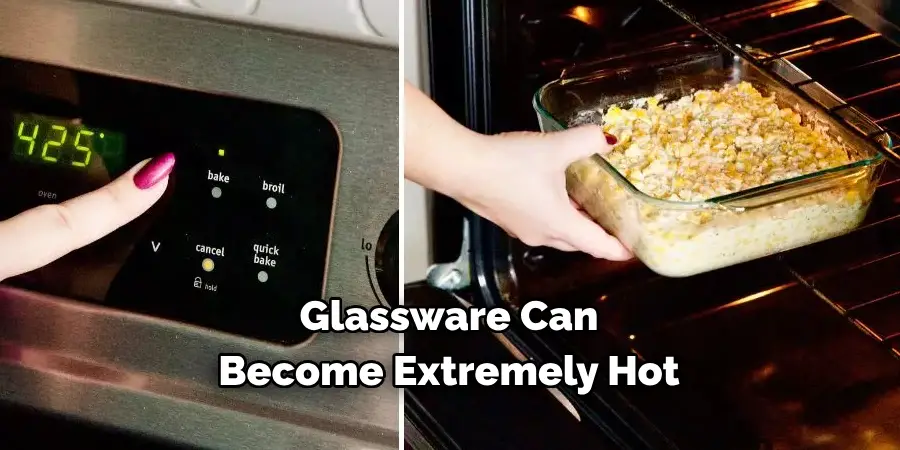
Frequently Asked Questions
Q: Is It Safe to Use Vintage or Antique Glassware in an Oven?
A: Generally, it is not recommended to use vintage or antique glassware in an oven. Even if you are able to find information about the manufacturer of the glass, it may not be designed to handle high temperatures. It’s best to choose a modern piece of oven-safe glassware that is specifically designed for use in the heat.
Q: Can You Put Glass in a Convection Oven?
A: Yes, you can put glass in a convection oven as long as it is labeled oven-safe and made from materials that are suitable for high temperatures. Make sure to double-check the product’s packaging and instructions before use, and never attempt to use glassware in a convection oven if it is not explicitly labeled as such.
Q: Can You Put Glass in the Microwave?
A: In most cases, no – you should not put glass in a microwave unless it is specifically designed for microwave use. Different types of glassware have different safety ratings, so it’s important to check the manufacturer’s instructions carefully before putting any type of glass in a microwave oven.
Q: Can You Put Stoneware in the Oven?
A: Yes, you can put stoneware in an oven – as long as it is rated for oven use. Many types of stoneware are designed to withstand high temperatures and are perfect for baking and roasting. However, it’s always important to double-check the product’s instructions before use to ensure that it is safe for oven temperatures.
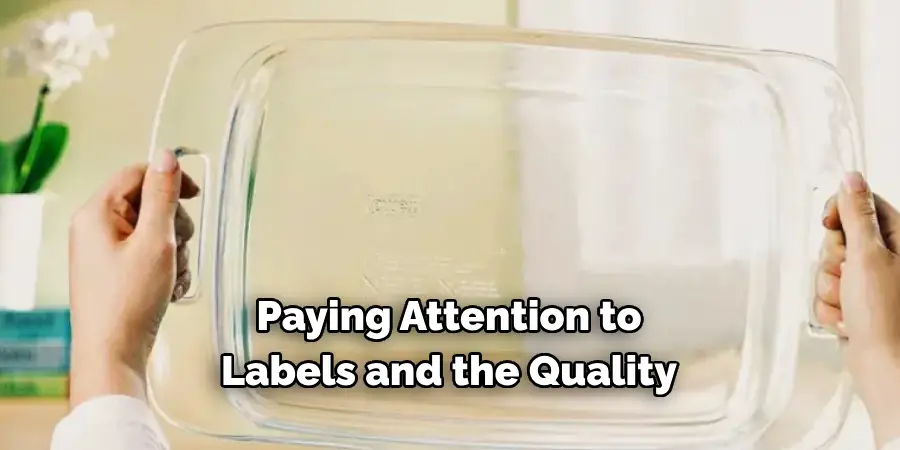
Conclusion
To sum it up, determining if glass is oven-safe is not always a straightforward task, and you should never guess. However, if you follow these simple steps, you’ll be able to tell if that glass container can safely be used in the oven. Paying attention to labels and the quality of the material, assessing the thickness, avoiding extreme temperature changes with sudden shocks of heat or cold, and being mindful of how it was tempered will ensure your safety. As an extra precautionary measure to protect yourself and your home kitchen from accidents and harm, always remember no risk is ever worth taking when it comes to cooking with glass in the oven.
Therefore, use caution and pay attention when choosing glass containers for baking since not all types are safe for this kind of use. Now that you have key guidelines on how to tell if glass is oven safe, you can purchase a quality container with peace of mind – happy cooking!

